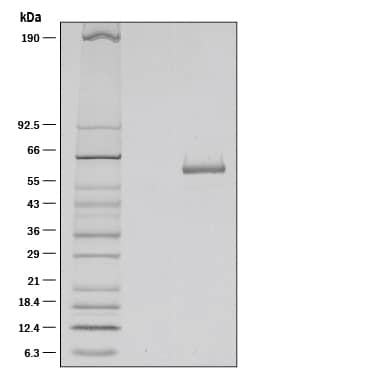Recombinant Mouse IL-27 (NS0-expressed) Protein
R&D Systems, part of Bio-Techne | Catalog # 2799-ML

Key Product Details
Product Specifications
Source
| Mouse EBI3 (Tyr19-Pro228) Accession # O35228 |
GGGSGGGSGGGSGGGS | Mouse p28 (Phe29-Ser234) Accession # Q8K3I6 |
6-His tag |
| N-terminus | C-terminus | ||
Purity
Endotoxin Level
N-terminal Sequence Analysis
Predicted Molecular Mass
SDS-PAGE
Activity
The ED50 for this effect is 0.6-6 ng/mL.
Reviewed Applications
Read 4 reviews rated 5 using 2799-ML in the following applications:
Scientific Data Images for Recombinant Mouse IL-27 (NS0-expressed) Protein
Recombinant Mouse IL-27 (NS0-expressed) Protein Bioactivity
Recombinant Mouse IL-27 (Catalog # 2799-ML) demonstrates anti-viral activity in HepG2 human hepatocellular carcinoma cells infected with encephalomyocarditis (EMC) virus. The ED50 for this effect is 0.6-6 ng/mL.Recombinant Mouse IL-27 (NS0-expressed) Protein SDS-PAGE
1 μg/lane of Recombinant Mouse IL-27 was resolved with SDS-PAGE under reducing (R) conditions and visualized by silver staining, showing a single band at 61 kDa.Formulation, Preparation and Storage
Carrier Free
What does CF mean?CF stands for Carrier Free (CF). We typically add Bovine Serum Albumin (BSA) as a carrier protein to our recombinant proteins. Adding a carrier protein enhances protein stability, increases shelf-life, and allows the recombinant protein to be stored at a more dilute concentration. The carrier free version does not contain BSA.
What formulation is right for me?In general, we advise purchasing the recombinant protein with BSA for use in cell or tissue culture, or as an ELISA standard. In contrast, the carrier free protein is recommended for applications, in which the presence of BSA could interfere.
Carrier: 2799-ML
| Formulation | Lyophilized from a 0.2 μm filtered solution in PBS and CHAPS with BSA as a carrier protein. |
| Reconstitution | Reconstitute at 100 μg/mL in sterile PBS containing at least 0.1% human or bovine serum albumin. |
| Shipping | The product is shipped at ambient temperature. Upon receipt, store it immediately at the temperature recommended below. |
| Stability & Storage | Use a manual defrost freezer and avoid repeated freeze-thaw cycles.
|
Carrier Free: 2799-ML/CF
| Formulation | Lyophilized from a 0.2 μm filtered solution in PBS and CHAPS. |
| Reconstitution | Reconstitute at 100 μg/mL in PBS. |
| Shipping | The product is shipped at ambient temperature. Upon receipt, store it immediately at the temperature recommended below. |
| Stability & Storage | Use a manual defrost freezer and avoid repeated freeze-thaw cycles.
|
Background: IL-27
IL-27 is a heterodimeric group 2 receptor ligand molecule that belongs to the IL-6/IL-12 family of long type I cytokines (1). It is composed of EBI3 (EBV-induced gene 3), a 34 kDa glycoprotein that is related to the p40 subunit of IL-12 and IL-23, and p28, the cloned 28 kDa glycoprotein that is related to the p35 chain of IL-12 (2-4). The mouse EBI3 gene encodes a 228 amino acid (aa) precursor that contains an 18 aa signal peptide and a 210 aa mature protein (5). The mature region contains two potential N-linked glycosylation sites, two fibronectin type III domains, and two pairs of conserved cysteine residues that place the molecule in the type I cytokine receptor family (5). As with p40, (the EBI3 counterpart in IL-12), IL-27 EBI3 is reported to form homodimers (6). Mouse EBI3 is 61% and 66% aa identical to human and bovine EBI3. The mouse p28 gene encodes a 234 aa precursor that contains a 28 aa signal sequence and a 206 aa mature region (7). The mature region is characterized by the presence of one potential N-linked glycosylation site and four alpha-helices, placing it in the IL-6 family of helical cytokines. Mouse p28 is 74% aa identical to human p28. IL-27 is expressed by monocytes, endothelial cells and dendritic cells (8). IL-27 binds to and signals through a heterodimeric receptor complex composed of WSX-1 (TCCR) and gp130. Evidence suggests IL-27 interacts only with WSX-1 (7, 9, 10). IL-27 has both anti- and proinflammatory properties. As an anti-inflammatory, IL-27 seems to induce a general negative feedback program that limits T and NK-T cell activity (3, 8). At the onset of infection, IL-27 induces an IL-12 receptor on naïve CD4+ T cells, making them susceptible to subsequent IL-12 activity (and possible Th1 development) (6). Notably, IL-12 family cytokines are both induced and inhibited by bacterial products. Microbes promote IL-27 secretion through TLR4, and also block IL-27 production via C5a induction (11).
References
- Boulay, J-L. et al. (2003) Immunity 19:159.
- Trinchieri, G. et al. (2003) Immunity 19:641.
- Murakami, M. et al. (2004) Growth Factors 22:75.
- Cordoba-Rodriguez, R. and D.M. Frucht (2003) Expert Opin. Biol. Ther. 3:715.
- Nomura, H. et al. (1997) GenBank Accession # O35228.
- Holscher, C. (2004) Med. Microbiol. Immunol. (Berl). 193:1.
- Pflanz, S. et al. (2002) Immunity 16:779.
- Villarino, A.V. et al. (2004) J. Immunol. 173:715.
- Pflanz, S. et al. (2004) J. Immunol. 172: 2225.
- Scheller, J. et al. (2005) Biochem. Biophys. Res. Commun. 326:724.
- Hawlish, H. et al. (2005) Immunity 22:415.
Long Name
Alternate Names
Gene Symbol
UniProt
Additional IL-27 Products
Product Documents for Recombinant Mouse IL-27 (NS0-expressed) Protein
Product Specific Notices for Recombinant Mouse IL-27 (NS0-expressed) Protein
For research use only

